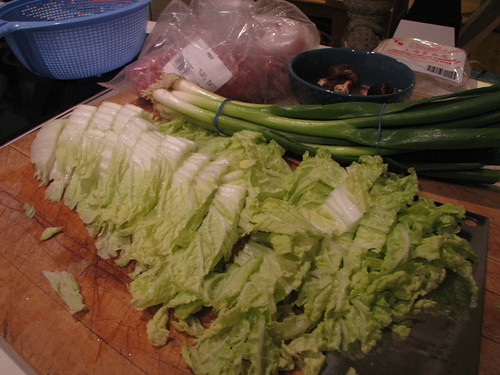One of the recurrent social activity involving food in my circle of friends, has been dumplings-making. In certain families, preparing dumplings (or also wonton) is something that you do every year during the Chinese New Year period. There is no such tradition in my family, although the chain-production of wontons by my father is something that seems to return every year or so.
Sometime last week, I had my friends over, and we prepared three different bowls of mix for Chinese-style dumplings, or 餃子 (jiaozi) in Chinese. One first friend, an international student from Sichuan, made a “traditional” mix, which did not contain anything but ground pork, seasoning, sesame oil and corn starch. My other friend, a Chinese Canadian originally from Hong Kong, who has a kick for cilantro, made a mix with ground pork, mashed nappa cabbage, green onions, seasoning, sesame oil, and a lot of coriander. My recipe, as seen on the picture (actually taken during a practice run, a few days earlier), consisted of the same thing as the previous friend’s, but without the cilantro, and instead with Chinese mushrooms (commonly known as shitake in the West), dried scallops.
I am not a fan of wontons, perhaps because we always had them, rather than dumplings. The difference is that dumplings have a thicker skin, and you can thus fry them in a pan. After wrapping our dumplings in varying shapes (which is the real fun part), we cooked them in two different ways:
- The first method was to throw them into a pot of scalding hot water, boil them for a while, and then interrupt the cooking by adding cold water. This is considered the “standard” method.
- The second method, maybe more tasty, but not as good for your health and a little high-maintenance. It requires you to directly put your dumplings over a pan with oil, fry them for ~5 minutes until the dumplings become crispy and brown, and then go through the non-intuitive step of adding water or broth to cover about 1/4 to 1/3 of the dumplings height. This is to cook the dumplings entirely. After boiling off the liquid, you would fry the dumplings some more for an extra crisp.
Ironically, we used wonton wrappers (Shanghai kinds) instead of dumpling ones. Because wonton wrappers are thinner, they are also more fragile and prone to breaking, after absorbing extra moisture from the meat filling.

